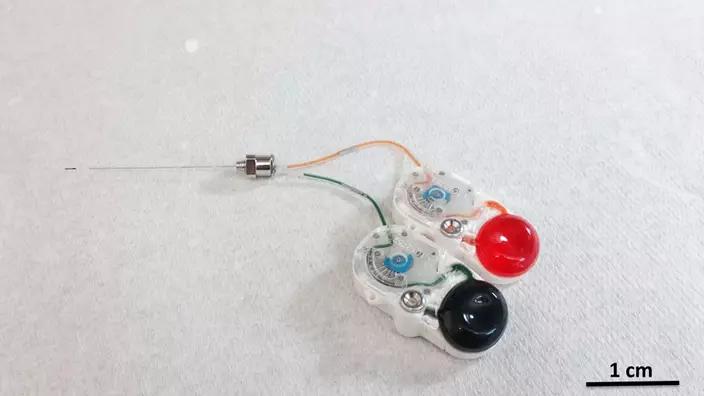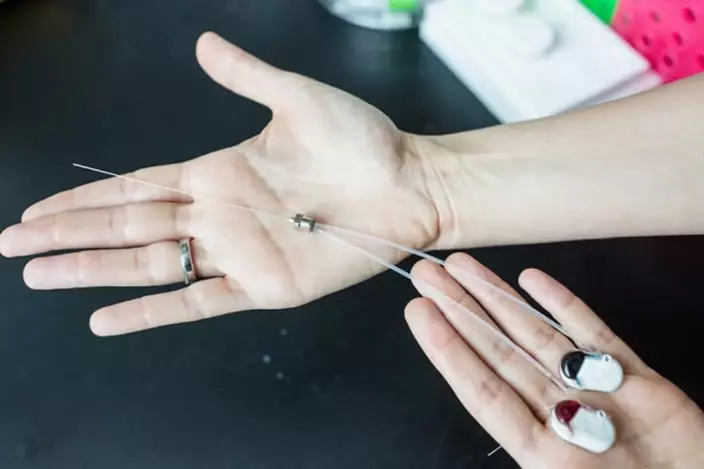Scientists have created a hair-thin implant that can drip medications deep into the brain by remote control and with pinpoint precision.

This undated image provided by researcher Canan Dagdeviren in January 2018 shows an implant that can precisely drip medications deep into the brain by remote control. (Canan Dagdeviren/Massachusetts Institute of Technology via AP)
Tested only in animals so far, if the device pans out it could mark a new approach to treating brain diseases — potentially reducing side effects by targeting only the hard-to-reach circuits that need care.
Click to Gallery
Scientists have created a hair-thin implant that can drip medications deep into the brain by remote control and with pinpoint precision.
Tested only in animals so far, if the device pans out it could mark a new approach to treating brain diseases — potentially reducing side effects by targeting only the hard-to-reach circuits that need care.
"You could deliver things right to where you want, no matter the disease," said Robert Langer, a professor at the Massachusetts Institute of Technology whose biomedical engineering team reported the research Wednesday.
Pills and IV drugs that make it inside trigger side effects as they wash over entire regions of the brain. So doctors have tried inserting tubes into the brain to pump drugs closer to their targets, but that risks infection and still isn't accurate enough. The most targeted success to date is a cancer treatment, a wafer placed on the site of a surgically removed brain tumor that oozes out chemotherapy.
The MIT team's next-generation approach: a customizable deep-brain implant that can deliver varying doses of more than one drug on demand.

The devices can be used to deliver tiny doses of one or more drugs./MIT Photo
"You could deliver things right to where you want, no matter the disease," said Robert Langer, a professor at the Massachusetts Institute of Technology whose biomedical engineering team reported the research Wednesday.
Stronger and safer treatments are needed for brain disorders ranging from depression to Parkinson's. Simply getting medications inside the brain, past what's called the blood-brain barrier, is a hurdle. It's even harder to reach its deepest structures.

From left to right, members of the MIT research team: Professor Robert Langer, Professor Ann Graybiel, Assistant Professor Canan Dagdeviren, and Professor Michael Cima. /MIT Photo
Pills and IV drugs that make it inside trigger side effects as they wash over entire regions of the brain. So doctors have tried inserting tubes into the brain to pump drugs closer to their targets, but that risks infection and still isn't accurate enough. The most targeted success to date is a cancer treatment, a wafer placed on the site of a surgically removed brain tumor that oozes out chemotherapy.

Dagdeviren (2nd right) developed the device while working as a postdoc in the labs of Graybiel (left), Cima (right), and Langer (far left)./MIT Photo
The MIT team's next-generation approach: a customizable deep-brain implant that can deliver varying doses of more than one drug on demand.
The researchers constructed two ultra-thin medication tubes and slid them into a stainless steel needle that's about the diameter of a human hair. That needle, built as long as needed to reach the right spot, gets inserted through a hole in the skull into the desired brain circuitry.
An electrode on the tip provides feedback, monitoring how the electrical activity of targeted neurons change as the medication is delivered.

CGTN Photo
The needle is hooked to two small, programmable pumps that hold the medications. The plan: Thread the pumps somewhere under the skin for a fully implantable system, dubbed MiNDS for miniaturized neural drug delivery system. The pumps can be refilled with an injection, and if more than two drugs are needed, additional reservoirs could be added like in a printer ink cartridge, Langer said.
Lab rats gave MiNDS its first test.
Researchers implanted the needle into a movement-related brain region that Parkinson's disease damages. To mimic that disease, the implant dripped out a chemical that made the rats move abnormally, including repeatedly turning clockwise. Next, the researchers turned off that chemical and infused saline through the system's second channel, ending the Parkinson's-like behavior, MIT lead author Canan Dagdeviren reported in the journal Science Translational Medicine.
Another experiment in a monkey showed delivering that same chemical into a different region altered how the targeted brain cells fire.
"There's a lot of therapeutic potential for this," said Tracy Cui, a bioengineering professor at the University of Pittsburgh. She wasn't involved with the MIT study but also is developing this kind of technology.
Numerous groups are working on implants to deliver neurologic drugs in different ways, Cui noted. While additional testing is needed before such a system could be tried in people, she said these kinds of tools are important for research thanks to the feedback showing how neurons react to different compounds.
The study was funded by the National Institutes of Health; MIT has applied for a patent.
WASHINGTON (AP) — With rare bipartisan momentum, the House pushed ahead Friday on a foreign aid package of $95 billion for Ukraine, Israel, Taiwan and humanitarian support as a robust coalition of lawmakers helped it clear a procedural hurdle to reach final votes this weekend. Friday’s vote produced a seldom-seen outcome in the typically hyper-partisan House, with Democrats helping Republican Speaker Mike Johnson’s plan advance overwhelmingly 316-94. Final House approval could come this weekend, when the package would be sent to the Senate.
It was a victory for the strategy Johnson set in motion this week after he agonized for two months over the legislation. Still, Johnson has had to spend the past 24 hours making the rounds on conservative media working to salvage support for the wartime funding, particularly for Ukraine as it faces a critical moment battling Russia, but also for his own job as the effort to remove him as speaker grew.
“Ukrainians desperately need lethal aid right now. ... We cannot allow Vladimir Putin to roll through another country and take it," Johnson told the conservative host of The Mark Levin Show about the Russian president's invasion of Ukraine. “These are very serious matters with global implications.”
Johnson said after the vote that while it wasn’t “perfect legislation," it was the “best possible product” Republicans can get given their thin majority in one chamber of Congress.
After months of delay, the House worked slowly but deliberately once Johnson made up his mind this week to plough ahead with a package that matches, with a few alterations, what the Senate passed in February. President Joe Biden sent a swift endorsement of the speaker's plan and, in a rare moment, Donald Trump, the Republican presumed presidential nominee who opposes most overseas aid for Ukraine, has not derailed the speaker's work.
“The world is watching what the Congress does," the White House said in a statement. "Passing this legislation would send a powerful message about the strength of American leadership at a pivotal moment.”
In an extremely rare step, the members of the House Rules Committee joined forces late Thursday in a near midnight vote, the four Democrats giving their support on a procedural step, to push past the Republican majority's three hardline holdouts to send the package to the House floor for debate on a 9-3 vote. It was a moment unseen in recent House memory.
Democratic leader Rep. Hakeem Jeffries said that he spoke with Johnson on Thursday night to ensure the bill would clear the Rules Committee.
"It’s long past time that we support our democratic allies,” Jeffries said after the vote.
“House Democrats have once again cleared the way for legislation that’s important to the American people.”
Johnson will need to rely on Democrats again Saturday to turn back amendments Republicans have offered that could kill the package. One from hardline Rep. Marjorie Taylor Greene would reduce spending for Ukraine to zero.
Greene has filed a “motion to vacate” the speaker from office, and it drew another supporter Friday as Rep. Paul Gosar, an Arizona Republican, co-sponsored the motion. Rep. Thomas Massie of Kentucky, another co-sponsor, suggested that before the House breaks next week others could follow, building pressure on Johnson to step down.
Rep. Eli Crane, a hardline conservative from Arizona, also said he was “open” to joining the move to oust Johnson.
“I definitely sense that there’s a souring to Republican leadership,” he said.
Greene could launch a bid to evict Johnson from the speaker's office, should she call it up for a vote, much the way Republicans booted Kevin McCarthy from the position last fall. Jeffries, the Democratic leader, remained noncommittal to helping Johnson keep the speaker's gavel, though some Democrats have suggested they would be inclined help defeat the motion to vacate through procedural maneuvers.
With one of the most narrow House majorities in modern times, Johnson can only afford to lose a single vote or two from his Republican ranks to pass any bill. That dynamic has thrust him into the arms of Democrats as he searches for votes to pass the package.
Without his Republican majority fully behind him, Johnson could not shape the package as the ultra-conservatives demand lest he lose Democratic backing. It forced him to leave behind tough security measures to clamp down on migration at the U.S.-Mexico border.
At best, Johnson has been able to carve up a Senate-passed version of the bill into separate parts, as is the preference among House Republicans, and the final votes will be on distinct measures — for Ukraine, Israel and Indo-Pacific allies.
The package would also include a fourth provision that includes many Republican priorities that Democrats endorse, or at least are willing to accept. Those include proposals that allow the U.S. to seize frozen Russian central bank assets to rebuild Ukraine; impose sanctions on Iran, Russia, China and criminal organizations that traffic fentanyl; and potentially ban the video app TikTok if its China-based owner doesn’t sell its stake within a year.
Rep. Gregory Meeks, the top Democrat on the House Foreign Affairs Committee, said the vote showed “the world that Democrats understand the world and our allies. That we’re going to stand by them and make sure that we give them the support and the aid that they need, that we care about humanitarian concerns.”
He added that in his 26 years in the House, he had never seen one party have to help the other like Democrats did this week.
“It just shows how the Republicans cannot manage the House and the House floor to get things done,” Meeks said.
Republicans, even those who supported the process, were severely disappointed it had come to this.
“I'm concerned,” said Rep. Ryan Zinke, R-Mont., who voted for the procedural step but, was nevertheless displeased with the process. “This is reflective of the controversy in the country: How much aid?”
Passing each bill, in votes expected Saturday, will require Johnson to form complicated bipartisan coalitions on each, with Democrats for example ensuring Ukraine aid is approved, but some left-leaning progressives refusing to back military aid for Israel over the destruction of Gaza. Still, Jeffries said that a majority of Democrats would vote Saturday for the packages of aid for Ukraine, Israel and allies in Asia.
The components would then be automatically stitched back together into a single package sent to the Senate where hardliners there are also planning procedural moves to stall final approval.

House Minority Leader Hakeem Jeffries, D-N.Y., walks with reporters after lawmakers pushed a $95 billion national security aid package for Ukraine, Israel and other U.S. allies closer to passage, at the Capitol in Washington, Friday, April 19, 2024. (AP Photo/J. Scott Applewhite)

Speaker of the House Mike Johnson, R-La., , center, stops to talk to reporters just after lawmakers pushed a $95 billion national security aid package for Ukraine, Israel and other U.S. allies closer to passage, at the Capitol in Washington, Friday, April 19, 2024. (AP Photo/J. Scott Applewhite)

Speaker of the House Mike Johnson, R-La., talks to reporters just after lawmakers in the House pushed a $95 billion national security aid package for Ukraine, Israel and other U.S. allies closer to passage, at the Capitol in Washington, Friday, April 19, 2024. (AP Photo/J. Scott Applewhite)

Speaker of the House Mike Johnson, R-La., talks to reporters just after lawmakers pushed a $95 billion national security aid package for Ukraine, Israel and other U.S. allies closer to passage, at the Capitol in Washington, Friday, April 19, 2024. (AP Photo/J. Scott Applewhite)

Speaker of the House Mike Johnson, R-La., speaks on Capitol Hill Wednesday, April 17, 2024, in Washington. (AP Photo/Mariam Zuhaib)
















